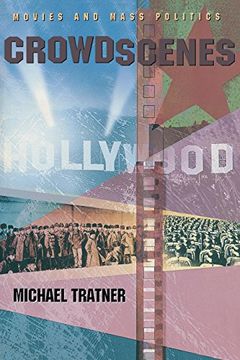Compartir
Crowd Scenes: Movies and Mass Politics (en Inglés)
Michael Tratner (Autor)
·
Fordham Univ Pr
· Tapa Blanda
Crowd Scenes: Movies and Mass Politics (en Inglés) - Michael Tratner
$ 189.947
$ 345.357
Ahorras: $ 155.411
Elige la lista en la que quieres agregar tu producto o crea una nueva lista
✓ Producto agregado correctamente a la lista de deseos.
Ir a Mis Listas
Origen: Estados Unidos
(Costos de importación incluídos en el precio)
Se enviará desde nuestra bodega entre el
Lunes 03 de Junio y el
Lunes 17 de Junio.
Lo recibirás en cualquier lugar de Colombia entre 1 y 5 días hábiles luego del envío.
Reseña del libro "Crowd Scenes: Movies and Mass Politics (en Inglés)"
The movies and the masses erupted on the world stage together. In a few decades around the turn of the twentieth century, millions of persons who rarely could afford a night at the theater and had never voted in an election became regular paying customers at movie palaces and proud members of new political parties. The question of how to represent these new masses fascinated and plagued politicians and filmmakers alike.Movies seemed to speak directly to the masses, via a form of crowd psychology that bypassed individual personality. Many political commentators believed that movies were inherently aligned with the new forms of collectivist mass politics―indeed, government control of the movie industry became a cornerstone of Communist and Fascist regimes, new political movements that embraced the crowd as the basis of social order.Michael Tratner examines the representations of masses―the crowd scenes―in Hollywood films from The Birth of a Nation through such popular love stories as Gone with the Wind, The Sound of Music, and Dr. Zhivago. He then contrasts these with similar scenes in early Soviet and Nazi films. What emerges is a political debate being carried out in filmic style. In both sets of films, the crowd is represented as a seething cauldron of emotions. In Hollywood films, this is depicted as molding private loves, while collectivist movies present it as turning into organized mass movements. Crowd scenes do more than provide backgrounds for stories, that is: they also function as models for the crowd in the theater.The book concludes with an examination of the films of Fritz Lang, who first in pre-Nazi Germany, then in Hollywood, created movies that can be seen as meditations on both these ways of using the crowd.
- 0% (0)
- 0% (0)
- 0% (0)
- 0% (0)
- 0% (0)
Todos los libros de nuestro catálogo son Originales.
El libro está escrito en Inglés.
La encuadernación de esta edición es Tapa Blanda.
✓ Producto agregado correctamente al carro, Ir a Pagar.

